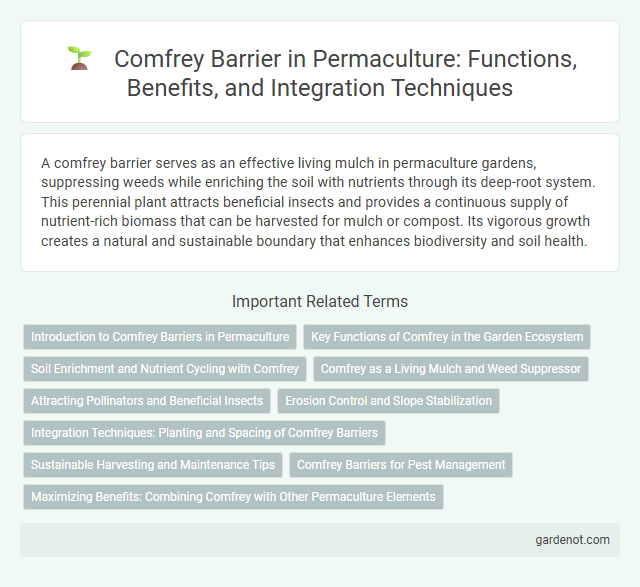A comfrey barrier serves as an effective living mulch in permaculture gardens, suppressing weeds while enriching the soil with nutrients through its deep-root system. This perennial plant attracts beneficial insects and provides a continuous supply of nutrient-rich biomass that can be harvested for mulch or compost. Its vigorous growth creates a natural and sustainable boundary that enhances biodiversity and soil health.
Introduction to Comfrey Barriers in Permaculture
Comfrey barriers are a vital component in permaculture for their ability to suppress weeds and improve soil fertility through dynamic nutrient accumulation. Their deep roots mine minerals from subsoil layers, which are deposited as nutrient-rich mulch when the leaves are cut and spread. This natural cycle enhances plant growth, supports soil health, and promotes sustainable garden ecosystems.
Key Functions of Comfrey in the Garden Ecosystem
Comfrey serves as a dynamic nutrient accumulator, drawing deep soil minerals to the surface, enriching garden beds with essential nutrients like potassium and calcium. Its dense foliage acts as a natural mulch, suppressing weeds and retaining soil moisture, thereby enhancing soil health and fertility. The plant's rapid growth and abundant biomass provide valuable organic matter for composting, supporting sustained productivity in permaculture systems.
Soil Enrichment and Nutrient Cycling with Comfrey
Comfrey barriers act as dynamic nutrient accumulators, mining deep soil layers to bring potassium, nitrogen, and phosphorus to the surface. Their extensive root systems contribute to improved soil structure by increasing organic matter and stimulating microbial activity. Regularly harvesting comfrey leaves recycles concentrated nutrients back into the garden, enhancing soil fertility and promoting efficient nutrient cycling in permaculture systems.
Comfrey as a Living Mulch and Weed Suppressor
Comfrey acts as an effective living mulch, creating a dense ground cover that naturally suppresses weed growth by blocking sunlight and outcompeting invasive plants. Its deep roots draw up essential nutrients like potassium and phosphorus, enriching the soil and promoting healthier surrounding vegetation. This makes comfrey an invaluable component in permaculture designs, enhancing soil fertility and reducing the need for chemical weed control.
Attracting Pollinators and Beneficial Insects
Comfrey barriers create vibrant habitats that attract pollinators such as bees, butterflies, and hoverflies, essential for improving crop yields in permaculture gardens. The dense foliage and abundant flowers provide shelter and nectar, supporting beneficial insects like predatory beetles and parasitic wasps that naturally control pests. Integrating comfrey barriers enhances biodiversity and promotes a balanced ecosystem, reducing the need for chemical interventions.
Erosion Control and Slope Stabilization
Comfrey barrier plants provide dense root networks that effectively bind soil, reducing erosion on slopes by minimizing surface runoff and soil displacement. Their deep roots penetrate compacted ground, enhancing slope stabilization and promoting water infiltration. Utilizing comfrey as a natural erosion control method supports sustainable permaculture design by maintaining soil health and preventing land degradation.
Integration Techniques: Planting and Spacing of Comfrey Barriers
Comfrey barriers thrive when planted in rows spaced 60-90 cm apart, allowing optimal airflow and nutrient absorption while minimizing overcrowding. Integrating comfrey as a dynamic accumulator near fruit trees or vegetable beds enhances soil fertility and moisture retention through its deep taproot system. Proper spacing ensures efficient nutrient cycling and prevents competition, boosting overall permaculture system productivity.
Sustainable Harvesting and Maintenance Tips
Comfrey barriers promote sustainable harvesting by encouraging regular leaf pruning, which stimulates new growth and ensures a continuous supply of nutrient-rich foliage for mulch or compost. Maintaining a healthy comfrey barrier involves cutting leaves before flowering to prevent seeding and dividing roots every few years to rejuvenate plant vigor. Implementing these practices conserves soil fertility while supporting ecological balance in permaculture gardens.
Comfrey Barriers for Pest Management
Comfrey barriers serve as an effective natural pest management strategy by repelling harmful insects and attracting beneficial predators within permaculture systems. The deep-rooted comfrey plants improve soil health by accumulating nutrients, which supports robust plant growth and reduces pest vulnerability. Integrating comfrey barriers around crops creates a dynamic ecosystem that enhances pest resistance without relying on chemical pesticides.
Maximizing Benefits: Combining Comfrey with Other Permaculture Elements
Planting a comfrey barrier alongside fruit trees enhances nutrient cycling by accumulating deep minerals and making them accessible through its nutrient-rich leaves. Integrating comfrey with chickens provides natural pest control and fertility, as poultry help spread comfrey mulch and manure while controlling insects. Combining comfrey barriers with swales and mulch layers maximizes soil moisture retention and supports diverse plant growth, reinforcing the polyculture's resilience and productivity.
Comfrey barrier Infographic

 gardenot.com
gardenot.com